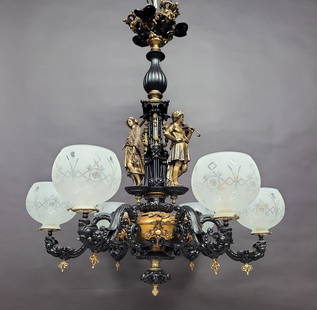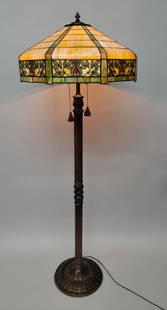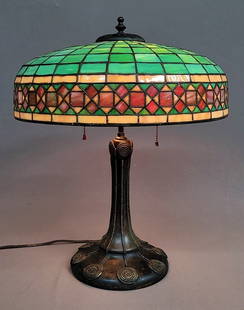
19th C. Russian Cloisonne Kovsh and Spoon
Similar Sale History
View More Items in Tableware & BarwareRelated Tableware & Barware
More Items in Tableware & Barware
View MoreRecommended Home & Décor
View More







Item Details
Description
Eastern Europe, Russia, Moscow, Imperial Period, ca. late 19th to early 20th century CE. A stunning pair of cloisonne enamel and gilded, high quality silver dishes: a serving vessel known as a kovsh and a spoon. The elegant serving bowl presents in the form of a bird displaying a head with a long, curved beak on one end and a pointed tail on the other, along with a flat, ovoid base and a wide rim. The head of the avian dish is angled down as though eating or pecking at the ground. Alternatively, the spoon features a slender stem, a twisted handle and flared finial at its tip. Both dishes are covered with vibrant cloisonne in hues of ultramarine, emerald, scarlet, periwinkle, teal, light green, burgundy, and white. The motifs are floral and vegetal with some geometric or linear patterns. Kovsh are traditional drinking vessels with shapes that may reflect Viking longships. Over the ages their designs and materials became more ornate, and pieces like this set eventually became symbolic gifts presented by the Tsar to important members of government or citizens. Size of largest: 10" L x 4.625" W x 4.75" H (25.4 cm x 11.7 cm x 12.1 cm); Silver quality: 96.5% (kovsh), 93% (spoon); Weight: 538.6 grams (kovsh), 49.2 grams (spoon)
On the base of the vessel are 2 hallmarks. The first shows a face in profile to the left with the number "84" for the Russian silver purity. The other is a double-headed eagle Cyrillic script that is seemingly consistant with the mark "K. FABERGE", indicating it could have possibly been sold by the Faberge Moscow branch and made by Julius Rappoport or Antti Nevalainen. The spoon exhibits 2 hallmarks: a right-facing profile with the number "88" for the silver purity and 2 letters that likely serve as a work master's mark.
From the mid-19th century to the early 20th, Russian art of all kinds experienced a renaissance that is known as the Silver Age. Russian artisans were inspired by the Gothic, the Moresque, Chinoiserie, the Baroque, the Rococo - all ornate styles, replete with scrolling vines and flourishing arches. They combined this with the bright colors and rich ornament of Old Russian applied art to create a unique style of which silver items like this vessel, are some of the most enduring. Later Russian artists in the 20th century recreated the styles pioneered by famous Russian silversmith firms like Ovchinnikov, Kurlyukov, the Grachev Brothers, and Faberge.
Provenance: ex-Collection of James Farmer, Maryland, collected from major galleries and auction houses between 1995 and 2005
All items legal to buy/sell under U.S. Statute covering cultural patrimony Code 2600, CHAPTER 14, and are guaranteed to be as described or your money back.
A Certificate of Authenticity will accompany all winning bids.
We ship worldwide to most countries and handle all shipping in-house for your convenience.
#120569
On the base of the vessel are 2 hallmarks. The first shows a face in profile to the left with the number "84" for the Russian silver purity. The other is a double-headed eagle Cyrillic script that is seemingly consistant with the mark "K. FABERGE", indicating it could have possibly been sold by the Faberge Moscow branch and made by Julius Rappoport or Antti Nevalainen. The spoon exhibits 2 hallmarks: a right-facing profile with the number "88" for the silver purity and 2 letters that likely serve as a work master's mark.
From the mid-19th century to the early 20th, Russian art of all kinds experienced a renaissance that is known as the Silver Age. Russian artisans were inspired by the Gothic, the Moresque, Chinoiserie, the Baroque, the Rococo - all ornate styles, replete with scrolling vines and flourishing arches. They combined this with the bright colors and rich ornament of Old Russian applied art to create a unique style of which silver items like this vessel, are some of the most enduring. Later Russian artists in the 20th century recreated the styles pioneered by famous Russian silversmith firms like Ovchinnikov, Kurlyukov, the Grachev Brothers, and Faberge.
Provenance: ex-Collection of James Farmer, Maryland, collected from major galleries and auction houses between 1995 and 2005
All items legal to buy/sell under U.S. Statute covering cultural patrimony Code 2600, CHAPTER 14, and are guaranteed to be as described or your money back.
A Certificate of Authenticity will accompany all winning bids.
We ship worldwide to most countries and handle all shipping in-house for your convenience.
#120569
Condition
Intact and excellent with lovely patina in areas.
Buyer's Premium
- 24.5%
19th C. Russian Cloisonne Kovsh and Spoon
Estimate $2,000 - $3,000
5 bidders are watching this item.
Shipping & Pickup Options
Item located in Louisville, CO, usOffers In-House Shipping
Local Pickup Available
Payment

TOP















































































